Inserting images into a lesson just because they look nice.
Instead you choose images that directly facilitate achievement of the learning outcome you are striving towards. Perfect! For those fans of images from the 17th, 18th and 19th century, I have good news. The British Library has released over 1 million illustrations into the public domain using the world’s largest image repository, Flickr. All clearly tagged on Flickr as public domain with no known copyright restrictions, you are free to download, use, modify, re-mix and re-purpose any of these images for whatever reason you see fit – including education of course. Have a look by heading over the British Library's photostream and searching it for your favourite keyword. A quick search on “Advertisement” yielded this beauty! From page 703 of the 1885 book entitled “History of Toronto and County of York, Ontario; containing an outline of the history of the Dominion of Canada ... biographical sketches, etc., etc. [By C. P. Mulvany, G. M. Adam and others.] Illustrated”Cool. So if you are doing a course on Canadian History, maybe this type of image can fall into a particular lesson. Maybe a scavenger hunt is in order. One that gives a bonus mark to the student who can obtain a picture of this building as it is today - over 125 years in the future - if it still exists! There are so many possibilities in a teaching setting.
Bonus Tip: if you find an interesting image in this collection, be sure to add more relevant tags to it to make it more easily searchable by others. Share the wealth!
If you have any tips for using images in relevant ways in your courses, please leave a comment below.
 Eric's ramblings, experiences and random thoughts about e-Learning, distance education and Educational Technology.
Eric's ramblings, experiences and random thoughts about e-Learning, distance education and Educational Technology.







2 comments:
My best guess is that this building was located at 28 King St West, Toronto, based on this ad for the Elias Rogers Coal Company that gives the address as such in this article: http://torontoist.com/2010/01/historicist_a_business_quartet/ . Here's the area today:
http://goo.gl/maps/9Dwso . Sadly, the beautiful building, if I'm right, no longer exists.
By the way, I found several versions of the book you cited as the source for the image/advertisement you included, but none of them had a page 703, except ones that combined volume I and II, and those only had a "virtual" page 703, by virtue of the new, electronic numbering.
-Luke Stollings, Austin TX
Hi Luke,
Great sleuthing! Isn't the Internet great? This just goes to show that a lot of interesting activities can be performed using historic images.
All the best,
-Eric
Post a Comment